Buenos Aires can seem alarmingly sprawling, and indeed it is, but the areas that most appeal to visitors are not difficult to reach. Our advice is to start from the city’s central point, the Obelisk on the Plaza de la República, the standout landmark in the downtown Microcentro district.
It’s a short walk to the Plaza de Mayo square with the white Pirámide obelisk, an icon that marks the foundation of the city in 1536, the pink Casa Rosada presidential palace, and the cathedral which looks more like a Greek temple. Closer to the Obelisk, the historic Confitería La Ideal café recently reopened after a handsome makeover. Popular from breakfast to dinner, it has a show-stopping cocktail for two, the Vermù Ideal Para 2, an XL pitcher of your choice of vermouth accompanied by plates of salmon ravioli, arancini, salami, cheese, meatballs and more.
Nearby Calle Florida is pedestrian with shops, food outlets and Galerias Pacifico, which is one of the smartest malls. On the street level, Chimmy Churry has ultralight handmade 100 percent vegan sandals, sneakers and mules. The lower level has a large food hall and a Deli Market that stocks an attractive choice of Argentine wines, spirits, spices and preserves.
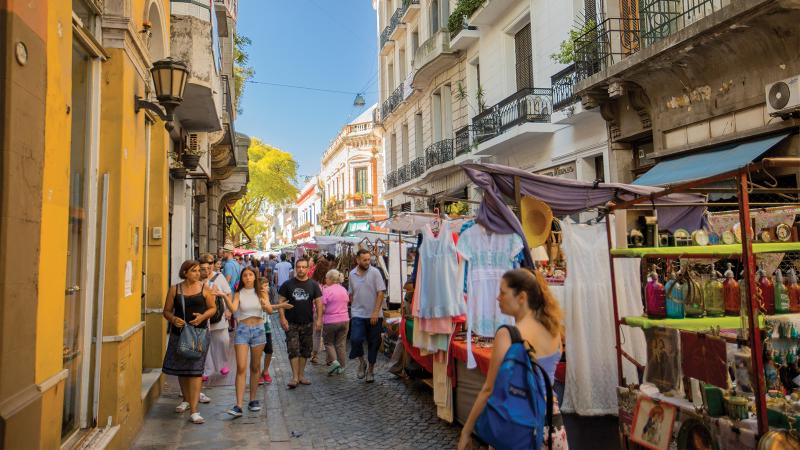
Across the street, the Escuela Mundial de Tango Gabriela Elias is the place to learn or improve your tango skills. There are walk-in classes for all levels from 11 a.m. to 10 p.m., as well as private lessons, and you can book ahead. Many of the professional dancers on the staff speak English, as did our great teacher Alejandro Turco Suaya, who coached us in the technique of dancing milonga-style like a Porteño, as the inhabitants of Buenos Aires are called.
A milonga is a traditional tango dance hall, with a DJ or a live orchestra, where aficionados, both locals and visitors from all over the world, go to dance. It is not to be confused with a tango show which is cabaret-style with professional dancers. Milongas, which serve drinks and light meals, usually start from 10.00 p.m. and can finish as late as 04.00 a.m. Check online at www.hoy-milonga.com/buenos-aires/en as they are not open every night. For tango shoes Darcos close to the Obelisk has a great selection of styles.
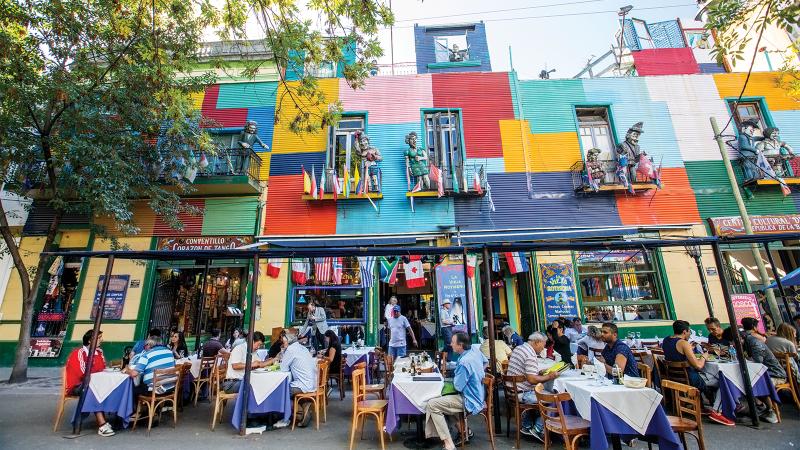
There are various ways to get around the city. Public buses, called colectivos, and the six lines of the Subte subway have fares starting from less than $0.30, but they can be very crowded. We used the Uber App to move around, and we always had a car within minutes. And, the best part was that thanks to the unofficial exchange rate, we spent less on four or five Ubers a day than on one taxi ride in New York or London. Although the parallel Blue Dollar rate fluctuates it is highly advantageous, but always use a hotel or an exchange office, and avoid the touts in tourist areas who can slip fake bills in with the real thing.
The ritzy Recoleta district is famous for its cemetery where historic figures like Evita Peron are buried. Tree-lined Avenìda Alvear has the most exclusive stores and galleries and two sumptuous five-stars. The Park Hyatt Palacio Duhau has a terraced garden and serves fine Argentine beef, cheeses and wines in the Duhau Restaurante & Vinoteca. The Alvear Palace Hotel has white-gloved waiters and Hermes amenities in the bathrooms. With all the trappings of a grand hotel, the Alvear Afternoon Tea is an elite affair with the house signature blend and savory and patisserie gourmet treats.
Palermo Alto and Palermo Chico have embassies, palatial homes, museums and parks, while Palermo Viejo divides into Palermo Soho and Palermo Hollywood, and what they all have in common is an uncommon number of top-notch restaurants. Many require reservations months ahead, and even the newer supercool establishments take forward planning, or a lot of patience waiting in line for the chance of a free table.
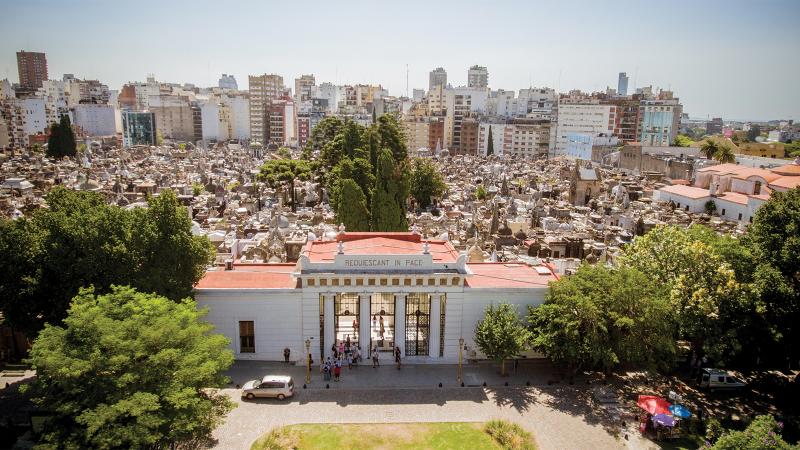
Buenos Aires is a paradise for carnivores. Top of every list, and a fixture in Latin America’s 50 Best Restaurants, the steaks waiting to go on the grill in Don Julio were the most spectacular we’d ever seen, as we sipped our complimentary sparkling wine—a great way to keep the waiting line happy. We had booked over three months ahead as you have to, though online you just might pick up a table weeks ahead, but it’s likely to be for the last 11:30 p.m. sitting. Add on the impeccable table service, and Don Julio is an experience in a million.
Close by, El Preferido is an old-fashioned bodega-style eatery with bookings two-three weeks out and tapas, sharing dishes and local favorites like milanesa and provoleta. Tre Monos shot into 27th place on the World’s Best 50 Best Bars last year. Using local ingredients its creative cocktails draw a young funky crowd, also for its sidewalk table snacks.
Casa Cavia is a historic town house in Palermo Chico with tables in elegant rooms and in a courtyard garden, fanciful cocktails and a small but elegant menu. Sophisticated Anafe started as a closed-door but, since its recent San Pellegrino and American Express One to Watch awards, advance bookings are essential. We loved the cool vibe, the interesting combinations, the hot and cold sharing plates, and the luscious desserts. And it has an excellent wine list.
For chic plant-based dining Palacio Duhau has the Gioia Cucina Botanica vegetarian restaurant with alfresco dining in the garden. Mudra, the trendy top floor in the Patagonia Flooring Art and Design Centre, has an exciting vegan menu with pizzas, burgers, sushi and cheesecake.
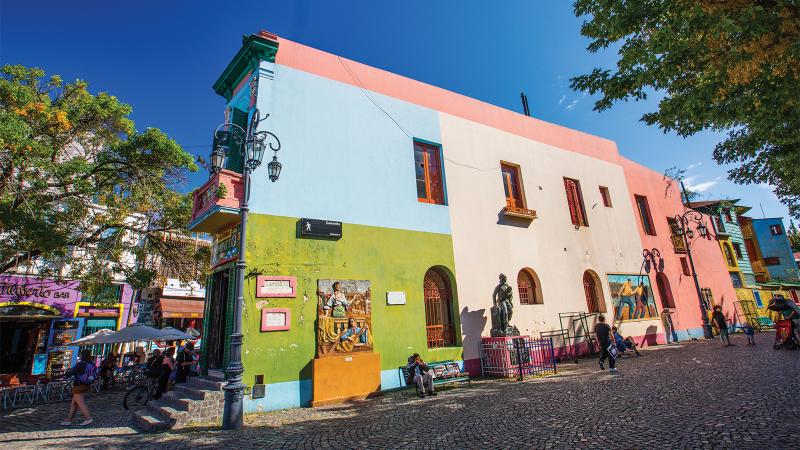
Avenida Santa Fe is a long and busy commercial avenue. El Ateneo, at number 1860, was named the world’s most beautiful bookstore by National Geographic. This old theater and cinema has rows of books on shelves where there were once theater seats (English titles are to the front of the store) and the café on the old stage serves cappuccinos. At Santa Fe 2729 the Galeria Patio del Liceo is a quiet courtyard with designer boutiques and workshops. Flor de Camisa sells brightly colored jungle-mood shirts, Raiz has sustainable handcrafts, Hola Lula is vintage, and upstairs there is a wineshop with wine by the glass.
Two of the city’s great museums—the MALBA Museum of Latin American Art and the Museo Nacional de Arte Decorativo—are free and beautiful. Nostalgics should add the Evita Peron Museum in an old mansion filled with memorabilia and personal artifacts of the former and much loved First Lady of Argentina.
The La Boca district dates back to the 19th-century immigration port, and its El Caminito street museum with brightly painted houses is a popular tourist selfie spot. Puerto Madero, the successful waterfront urban restoration of the rundown dock area, now has fashionable eateries and swanky hotels. The Hotel Faena, one of the best celeb-spotting venues, has the El Mercado parilla restaurant, the white-themed Bistro Sur and the acclaimed Rojo Tango dinner show. The art-oriented Accor SLS Puerto Madero is the Ennismore Group’s debut property in South America, a sleek low-rise with 58 luxury rooms, a swimming pool and facilities for disabled guests.
San Telmo is Buenos Aires’s oldest barrio, a bohemian maze of cobblestone streets, historic mansions and the central Plaza Dorrego square with bars and street tango music and dancing. Every Sunday it transforms into the city’s biggest street market with antique, vintage and handcraft stalls stretching along Defensa Street. In the Parilla La Brigada, the waiters like to show off how tender their grilled meats are by cutting them with two spoons. Disnivel, at number 855 Defensa Street, is an unpretentious local favorite, and one of my Buenos Aires friends swears it has the best steaks in town. El Zanjon also on Defensa is an interesting urban archeology site with an 1830s mansion, underground tunnels and La Casa Minima, the city’s narrowest house.
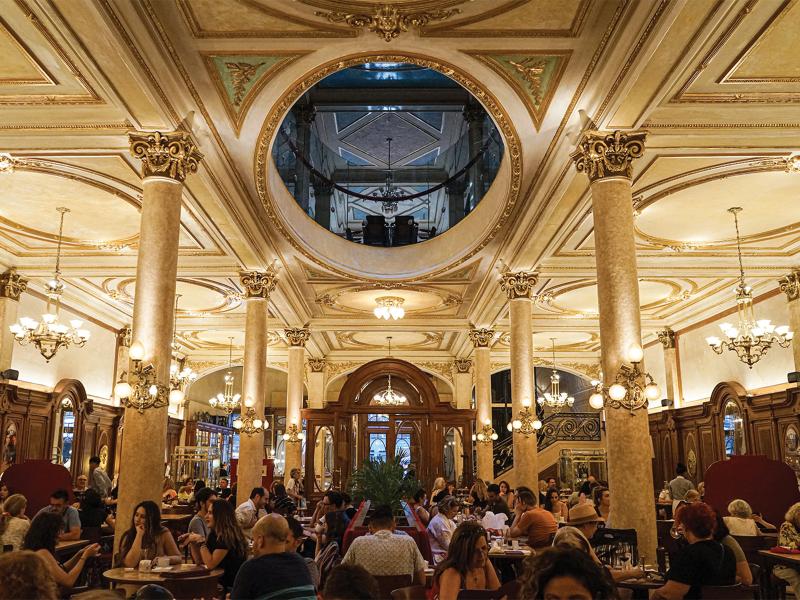
Rojo Tango at the Faena Hotel
The Faena Hotel, a lavish design property in the upscale waterfront Puerto Madero district, where Philippe Starck’s signature crimson interiors bedazzle, is also home to Rojo Tango, Buenos Aires’ most extravagant tango show. What makes this production outstanding? The atmospheric El Cabaret, which is charmingly intimate with tables, a vibrant five-piece orchestra and a stage that are so close the mood is like that of an exclusive private club. The charged atmosphere is enhanced by the tango dancers who flaunt their dazzling technical prowess around the tables, so every seat is a great seat. The three-course traditional dinner, with free-flow wines and champagne, starts at 8:30 p.m., and the 10:00 p.m. show is a spectacular 90 minutes of dancing and singing from the tango’s Golden Era to Astor Piazzolla classics.
Related Articles
Just Back: All Across Argentina
Just Back: Palacio Duhau - Park Hyatt Buenos Aires
Delta Adds Nonstop Service From Atlanta to Argentina and Chile
Luxury Wine Hotel Opens in Mendoza, Argentina